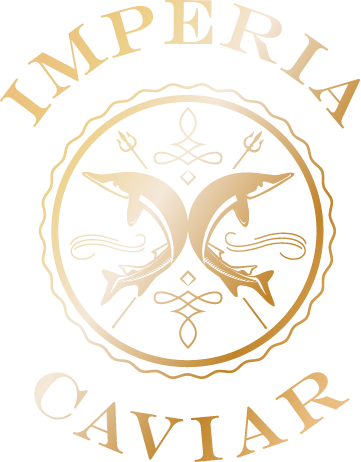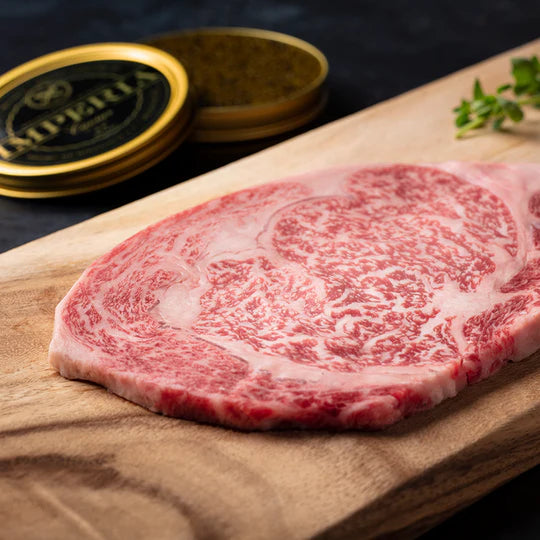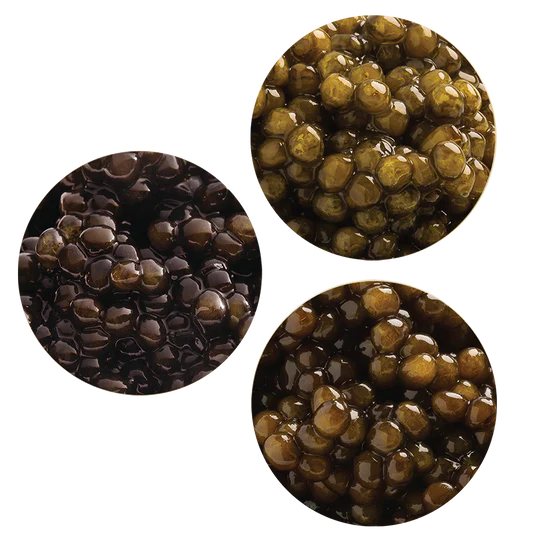
No matter where you're from, caviar is a luxury treat that tastes like no other — an exquisite delight that makes the taste buds dance with joy. As we know, caviar is the salted, non-fertilized eggs of the sturgeon. But where exactly does caviar come from? Learn about the history of caviar, how and where it's harvested, the common types of fish used and more.
History of Caviar
Caviar was once reserved strictly for the king and those of royalty, but later in America during the 19th century, caviar was casually served as a part of a free lunch! So, what happened?
The American caviar industry took off in 1873 when a German immigrant named Henry Schacht opened a business catching sturgeon on the Delaware River, which runs through Delaware, New Jersey, New York and Pennsylvania. The west coast soon followed and began harvesting sturgeon roe as well, but from the Columbia River. At that time, the American waters were abundant with sturgeon caviar, making the U.S. the largest caviar producer and exporter of caviar in the world!
In the 1900s, sturgeon populations were so overfished that they nearly met extinction. The sudden shortage caused a massive increase in the price of caviar due to how rare it was starting to become. By the 1960s, prices were so extreme that new sources of domestic caviar were sought. Today, 18 of the 27 sturgeon species in the world are endangered due to overfishing.
How Is Caviar Harvested?
When it comes to caviar, timing is everything. A female sturgeon’s eggs are the tautest and most flavorful three days before she is ready to spawn. If you take the eggs too early, they won’t have that trademark “pop” in your mouth when eaten. If the eggs are taken too late, they tend to be mushy. This makes timing crucial to perfecting caviar.
Harvesting the eggs is a time-consuming and delicate process because it is often done manually. Roe is fragile and can easily be damaged. There are two main caviar harvesting methods — the classic method and the humane method.
Classic Method
This traditional Iranian and Russian harvesting process has grown more controversial over the years, as it requires killing the fish to harvest its eggs:
- The harvester places the adult roe-bearing fish in ice-cold water to reduce its movement, lower the fat content and render it unconscious.
- While unconscious, the fish is killed quickly. The harvester then cleans all extremities with purified water.
- The harvester makes an incision along the stomach to remove the roe sacks.
- Once they remove the sacks, the harvester cleans them and sets the remainder of the fish aside to harvest the meat, skin and by-products.
- After the roe is harvested, cleaned, salted and packaged, it's ready to be marketed as caviar. Additionally, the sturgeon can be sold as edible fish meat, reducing waste.
Humane Method
Unlike the classic method, the humane harvesting method extracts the roe without killing the fish. While it's not an easy process, conservationists praise this method, as it helps increase the sustainability of certain sturgeon, especially endangered species:
1. Preparation
When an ovulating sturgeon is ready to lay her eggs, she is injected with a hormone several days before harvest — this separates the eggs from the membranous sac so they can come out with ease. If necessary, the fish will be sedated or cooled to prevent potential stress during the injection.
2. Removal
The harvester washes the fish in purified water and removes the eggs in one of two ways:
- C-section: The harvester makes a small incision on the stomach and carefully scoops the eggs out. The fish is then sewn back up and bandaged.
- Vivace: Rather than an incision, the harvester uses a fish-milking technique called striping to massage the roe out, imitating a natural delivery. After removing the eggs, the harvester rinses them in a water-calcium solution to maintain texture.
After performing the classic or humane method, the roe sacks are opened and rubbed across mesh screens to separate the eggs from the membrane. The eggs are then rinsed with cold water and salted. After several hours, the eggs, which are now caviar, are drained, graded and packed into small containers with airtight lids, keeping fresh for roughly two to four weeks.

What Are the Different Types of Caviar?
Caviar is distinguished by the different types of fish used to make caviar, where they're found and the distinct features of each caviar variety.
1. Types of Fish
To be considered true caviar, the unfertilized fish eggs — or roe — must come from wild sturgeon. A sturgeon is a large freshwater or saltwater fish that can grow over 1,000 pounds. There are 27 species of sturgeon belonging to the Acipenseridae family, typically found in the Iranian Caspian Sea and the Siberian Black Sea.
Roe refers to all fish eggs, including those from salmon, trout, flying fish and paddlefish. However, only roe from a sturgeon is true caviar. There are several types of sturgeon used to make caviar, such as:
- Beluga
- Kaluga
- Ossetra
- Hackleback
- Siberian
- Sterlet
- White
While there are many species of sturgeon, the highest quality caviar comes from Beluga, Kaluga, Ossetra, white sturgeon and Sevruga.
2. Geography
Commercial fishermen will typically find sturgeon swimming in the Siberian Black Sea and the Caspian Sea. Beluga Caviar is most commonly found in the Caspian Sea, which runs through Iran, Russia, Kazakhstan, Azerbaijan and Turkmenistan. Wild caviar in some of these countries has been made illegal, so aquaculture, or aquatic caviar farming, is a staple of caviar production.
Some other sturgeon species found in these waters are:
- Russian sturgeon
- Persian sturgeon
- Stellate sturgeon
- Ship sturgeon
- Sterlet sturgeon
While the above fish constitute true caviar, less traditional varieties can be found in other countries. For example, red caviar may be common in Russian cuisine, but you can find it in Japan as well. Here, salmon caviar — or ikura — is served in a variety of ways. It's often topped over rice or marinated with sake, salt and soy sauce.
There's also white caviar, also known as “snail caviar" or “escargot pearls.” This type of caviar is made from fresh or processed land snail eggs. This specialty is produced in Poland and France.
3. Types of Caviar
While there are thousands of different fish species swimming in the waters of the world, we know that real caviar only comes from the roe of a sturgeon fish, unlike salmon roe. Bursting with flavor, caviar is a unique experience that will take your taste buds to a whole new level of luxury. Many vendors offer salmon, capelin or trout caviar, but they're far from the real thing. There are four main types of sturgeon caviar:
-
Ossetra: This caviar has medium-sized eggs that range in color from light gray to dark brown. Ossetra caviar has a nutty and slightly salty flavor, giving it a richness that tastes of the sea.
Shop Ossetra Caviar - Sevruga: This fish produces smaller-sized eggs. It's the most popular, as it's readily available and more abundant than other types of sturgeon. Sevruga caviar eggs can be anywhere from gray to black in color and have a more intense flavor profile.
-
Kaluga: Also known as “River Beluga,” this sturgeon produces roes that range in color from a jaded bright bronze to a dark brown. The Kaluga is a giant sturgeon found in the Amur River basin on the border of Russia and China. It produces large to very large-sized eggs. Kaluga caviar is mild and buttery, making each bite one to savor.
Shop Kaluga Caviar - Beluga: Beluga caviar is considered the most exquisite and expensive caviar on the market today. This species of fish is critically endangered and the importation of Beluga caviar to the U.S. is illegal. The eggs are large, providing a creamy and mild flavor and ranging in color from light gray to black.
Appreciate the Taste and History of Imperia Caviar
After learning about the unique history and flavor characteristics of caviar, you may be inspired to try this delicacy for yourself. At Imperia Caviar, quality yet affordable caviar is our specialty. While we're based in Los Angeles, we ship to most locations across the United States, making it easy to enjoy the fresh flavor of caviar.
To experience this one-of-a-kind culinary delight at a reasonable price, browse our premium caviar selection and purchase yours today!
Last updated 11/08/22





Fish great o